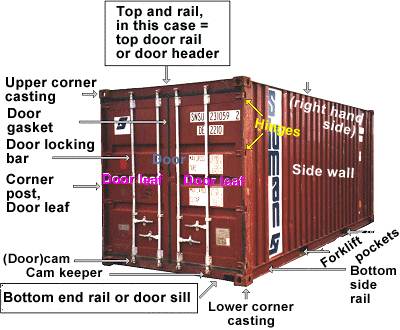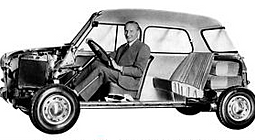Typically, only a fundamentally new way of 'looking at things' will really make a difference and stir new development. Not all innovation is based on whizkid ingenuity, however. Some of the 20th century's greatest ideas were actually based on plain common sense. Click on pictures to enlarge.

Did you know that so-called sloped armor - armor plating that is 'angled' backwards - was first used in World War 2 (approx. 25 years after the first tank was introduced during WW1)? Sloping an armor plate makes it harder to penetrate for anti-tank weapons. A projectile hitting a plate at an angle other than 90° has to travel a greater thickness, compared to hitting the same plate at a right-angle, and has a greater chance that it will get deflected. A simple idea, but the German Tiger didn't have sloped armor. The Russian T-34 tank you see on the left did. The same applies to "Elementary, my dear Watson" reactive armor, which signified the next big leap.
 The notion of geostationary orbit
- objects flying at a predetermined altitude and velocity that keep
them within the earth's gravitational pull in a fixed position - was
first disseminated on a wide scale in 1945 by SF- writer Arthur C.
Clarke. Yep, that is the same man who co-wrote on Stanley Kubrick's
'2001 - A Space Odyssey' movie. Without satellites circling the planet, worldwide communication and broadcasting would have been unthinkable.
The notion of geostationary orbit
- objects flying at a predetermined altitude and velocity that keep
them within the earth's gravitational pull in a fixed position - was
first disseminated on a wide scale in 1945 by SF- writer Arthur C.
Clarke. Yep, that is the same man who co-wrote on Stanley Kubrick's
'2001 - A Space Odyssey' movie. Without satellites circling the planet, worldwide communication and broadcasting would have been unthinkable. 
Shipping containers - weren't those obvious? Haven't we been trading, mass-transporting goods for the better part of the 20th century? Yes, we have. Nonetheless, it took until way after WW2 before trucking company owner Malcolm McLean introduced the modern intermodal container. Containerization dramatically reduced transport costs, changed the face of international trade, and formed a major contribution to globalization. It did away with the manual sorting of most shipments and the need for warehousing. Containers have standardized dimensions. They can be loaded and unloaded, stacked, transported efficiently over long distances, and transferred from one transportation mode to another - container ships, rail transport flatcars, and semi-trailer trucks - without being opened.
More than sixty years after the first automobile made its appearance Alec Issigonis' Mini was conceived, primarily because of a fuel shortage caused by the 1956 Suez Crisis. Petrol was rationed in the UK and car sales slumped. The Mini broke away from the usual setup by having the engine mounted transversely and by employing front-wheel drive. To optimize cabin space the wheels were pushed to the corners, which gave the Mini go kart-like handling. Almost all FWD hatchbacks developed since have used the same layout.
 Like the Mini, New iSetta is a concept that brings together many new elements. To be able to create a sleek shape (one of the biggest contributing factors to boost energy economy) whilst maintaining safety standards, passengers don't sit next to each other. The old Romans already knew that arches make for a stress-resistant construction. New Isetta has a Da Vinci-inspired cigar-like frame underneath the outer panels and a dual-purpose rear cowling, covering the twin wheels and integrating a flush-mounted rear bumper (a safety feature too). Lighter materials can be used. Besides, a vehicle that hinges on its (clustered) rear wheels displays
virtually no flex, contrary to a box resting on its four wheels. Space-efficient use of the infrastructure is a nice bonus. New Isetta will carry three persons more safely, economically and comfortably than a VW Polo, Opel Corsa, Renault Clio, etc. can. The passenger configuration depicted above is the UK version's, i.e. with the driver seated to the left (the EU/U.S. layout is depicted below). Why? NCAP crash testing.
Like the Mini, New iSetta is a concept that brings together many new elements. To be able to create a sleek shape (one of the biggest contributing factors to boost energy economy) whilst maintaining safety standards, passengers don't sit next to each other. The old Romans already knew that arches make for a stress-resistant construction. New Isetta has a Da Vinci-inspired cigar-like frame underneath the outer panels and a dual-purpose rear cowling, covering the twin wheels and integrating a flush-mounted rear bumper (a safety feature too). Lighter materials can be used. Besides, a vehicle that hinges on its (clustered) rear wheels displays
virtually no flex, contrary to a box resting on its four wheels. Space-efficient use of the infrastructure is a nice bonus. New Isetta will carry three persons more safely, economically and comfortably than a VW Polo, Opel Corsa, Renault Clio, etc. can. The passenger configuration depicted above is the UK version's, i.e. with the driver seated to the left (the EU/U.S. layout is depicted below). Why? NCAP crash testing.
